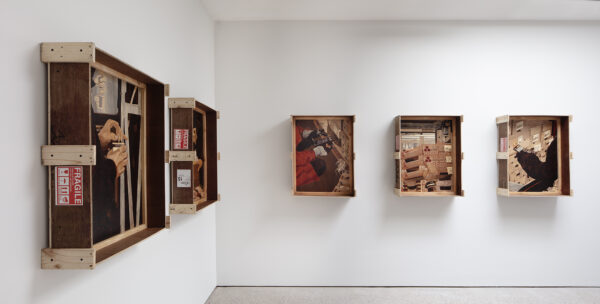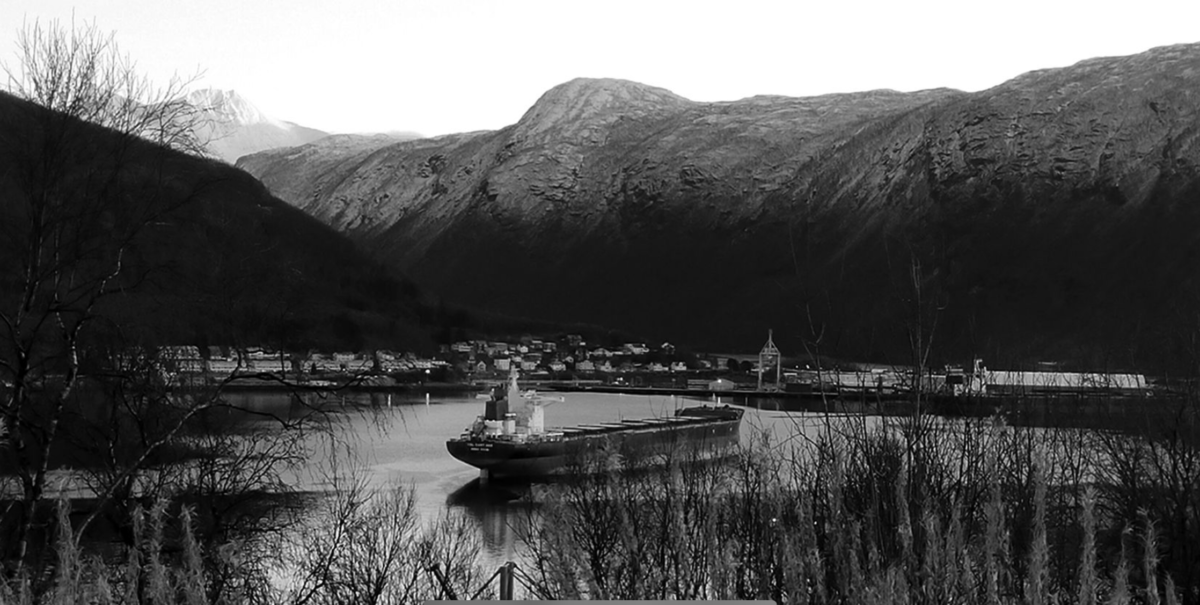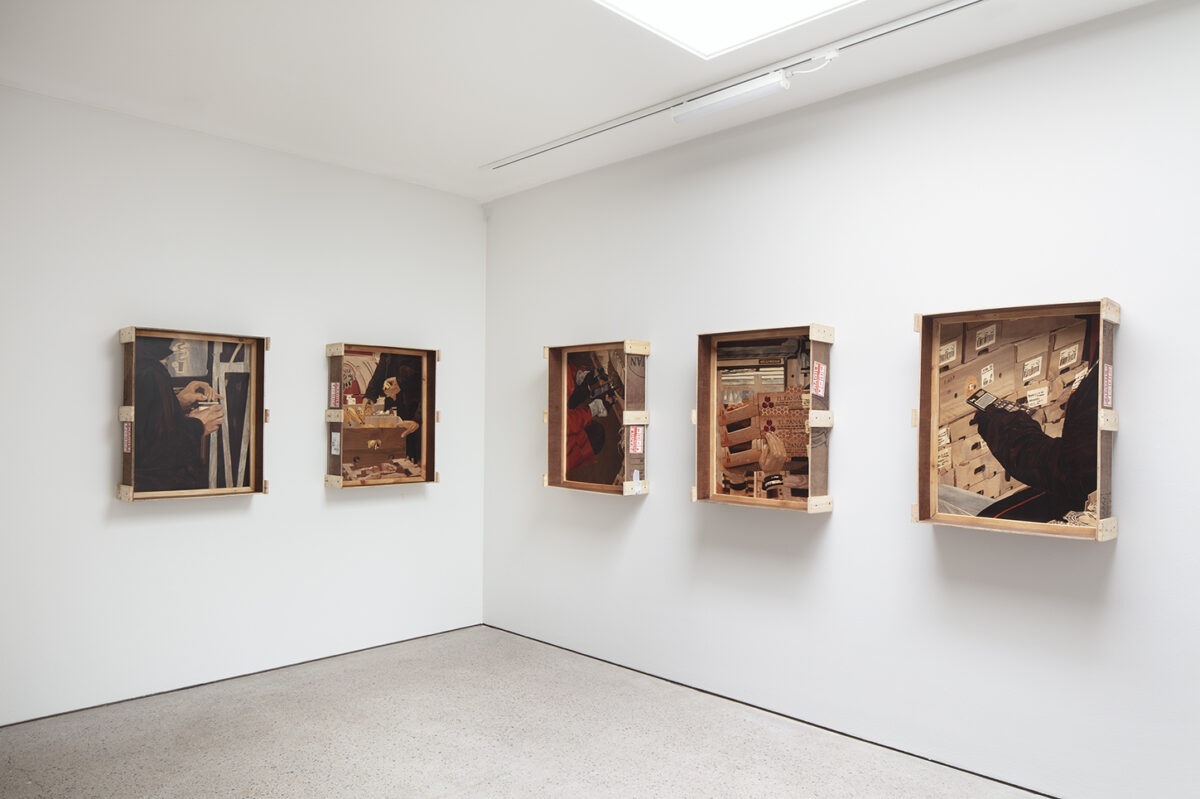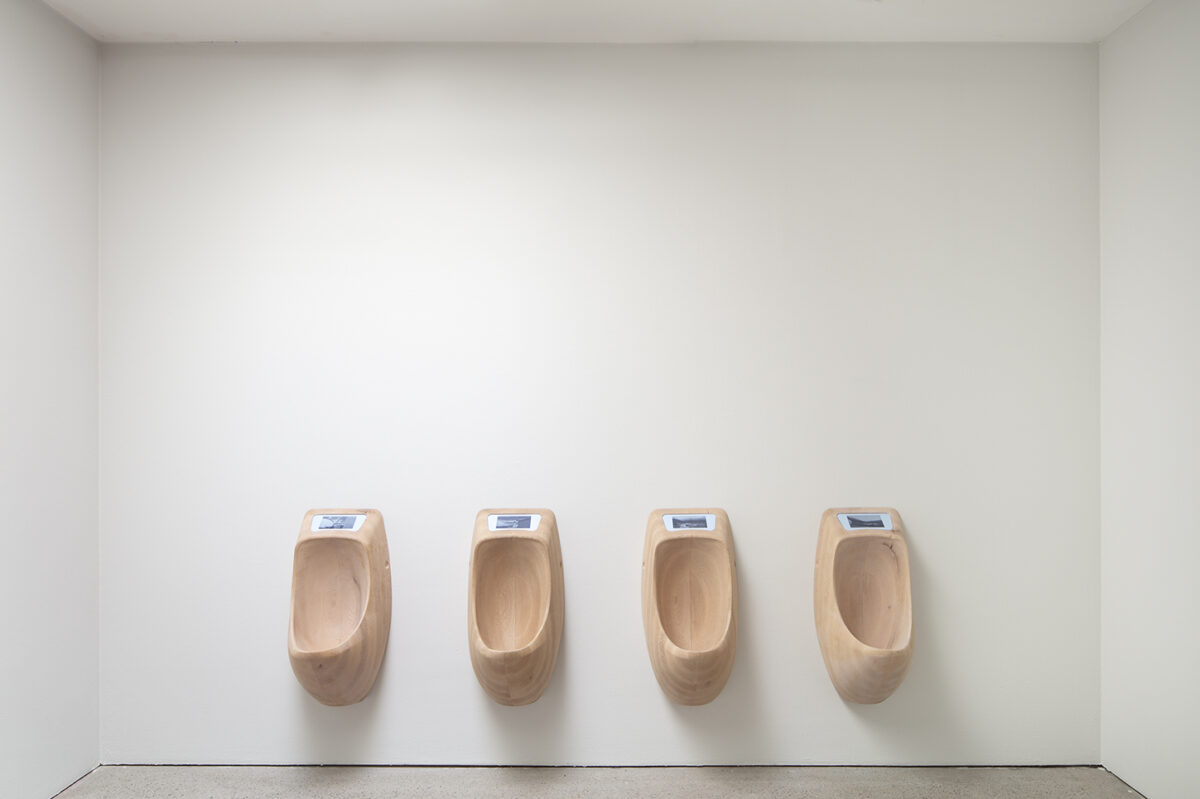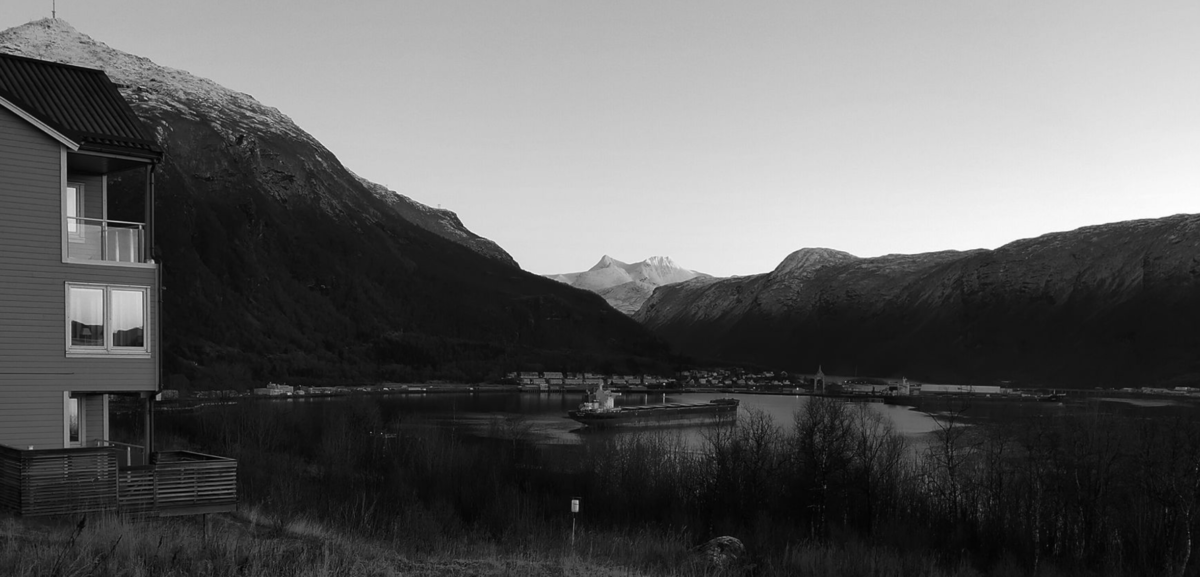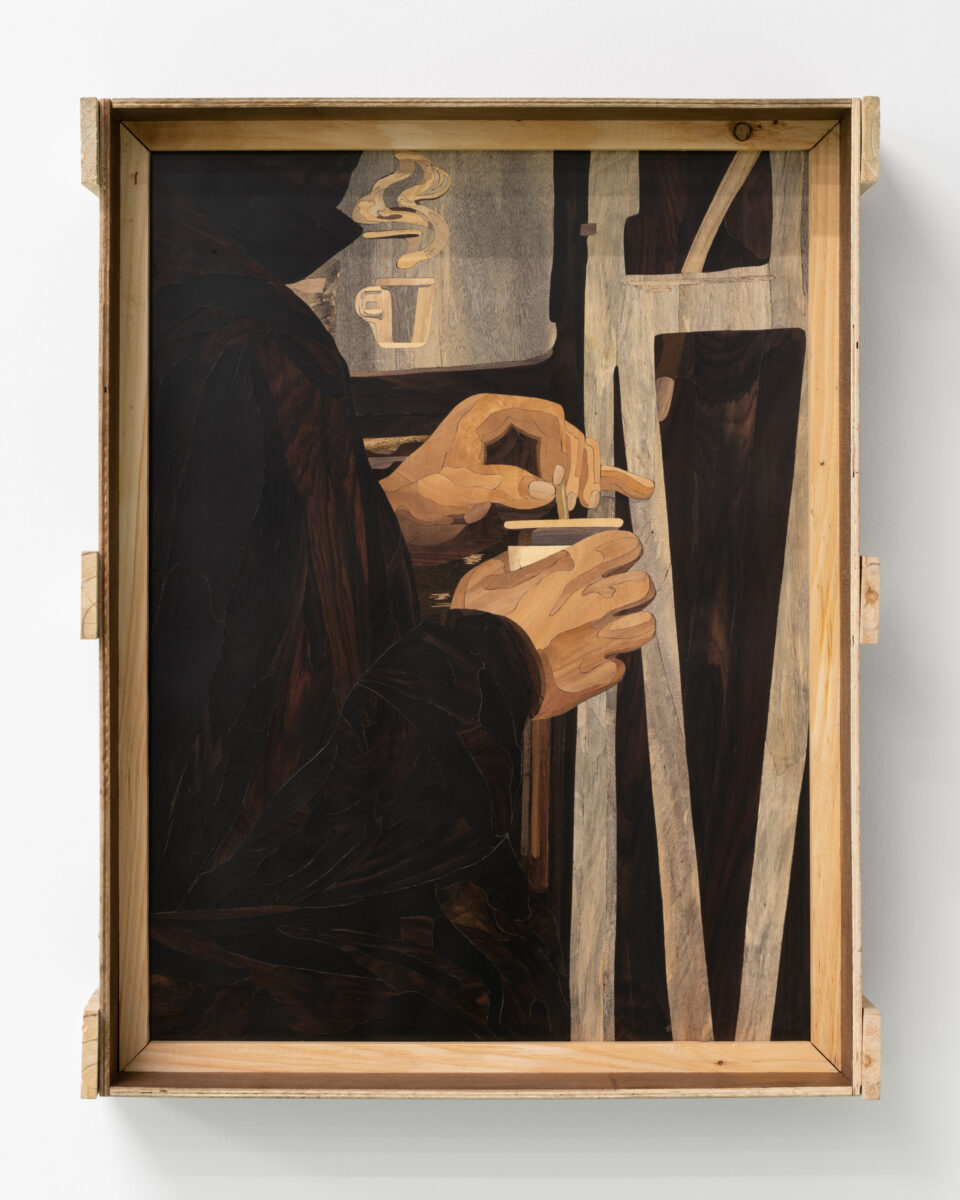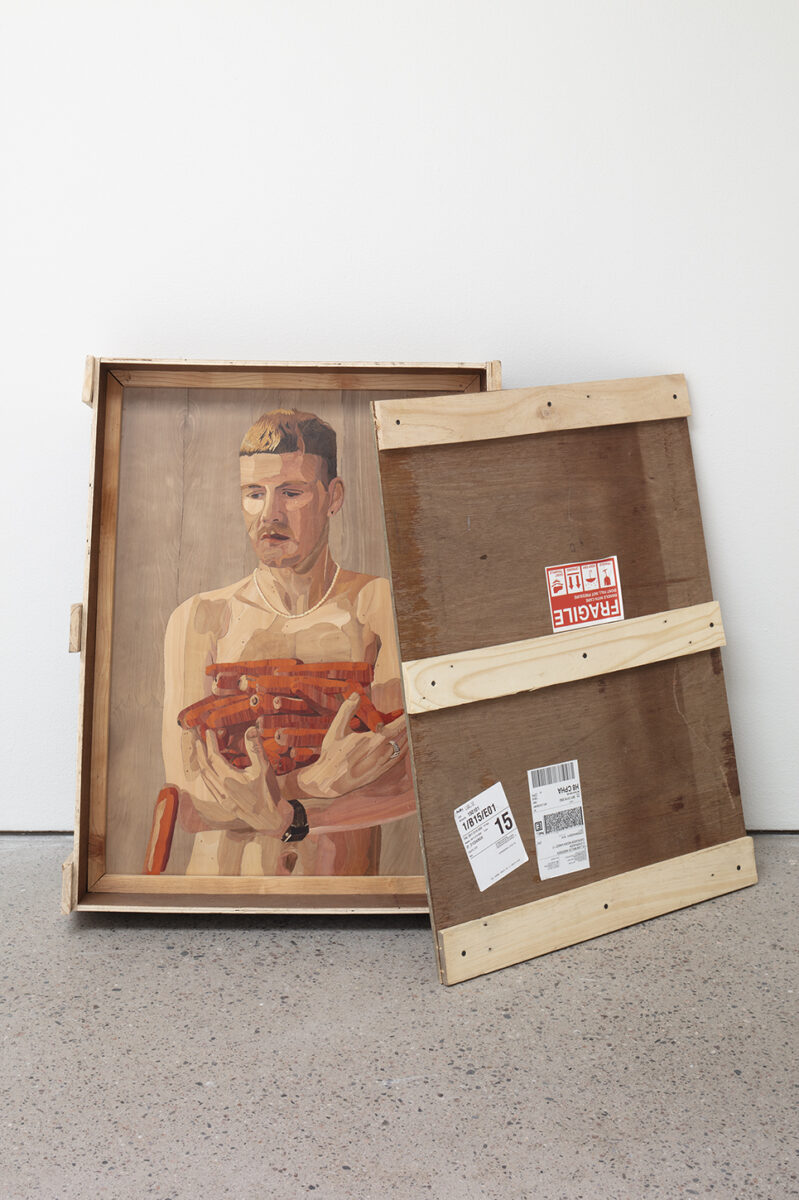It’s the afternoon on the 26th of February. Helsinki is overcast, two degrees celsius. The city is enveloped in a thick fog. Fog rises more frequently these days, probably due to some ominous changes in the climate.
Fog is a frequent metaphor, too, for describing this confused, distracted, atemporal space we inhabit. I don’t like the term ‘brain fog’ – the word ‘brain’ strips the word ‘fog’ of its Victorian poetics. I feel like I have brain fog. I like walking around in the literal fog: what is nearby becomes a circle of clarity, what is further fades into a pleasing grey opacity that no longer concerns me.
Villiam Miklos Andersen’s solo exhibition ‘Services’ will have its opening tonight at Kohta. I might attend. Before the opening I have a meeting. Online serendipity has led me to agree to a coffee with a journalist from a major American newspaper. She has flown to Finland to write about public space, or something.
I’m meandering in the fog, slowly making my way to the café, when I receive a message from the journalist. Her head has collided with a street sign in the fog and she needs to go back to her hotel to rest for a while. She wants to push our meeting back by an hour.
In the morning I’ve been reading about Trump and Putin and the KGB, thinking about wars hot and cold, about the long claw of the twentieth century that still holds us in its grip (I see a narrow hand of green-ish dead tissue with long fingernails made of colourless aluminium).
I imagine the journalist not noticing the sign in the fog before it made contact with her face. I think about countless collective failures to notice the signs that precede disaster. Or maybe there is just the noticing – a constant state of alarm. The image of a face and a street sign colliding conjures up another image: Charlie Chaplin’s body, precariously balanced on a giant gearwheel in Modern Times. This image then reminds me of what Giorgio Agamben wrote about ‘the inarticulate cry of the tragic body and the dumb silence of the comic body’. The thoughts short circuit and I stand still.
‘Oh no! I hope you’re OK?’ I text the journalist.
We end up meeting and despite the fog, despite these bad signs, the meeting goes well. Being the object of journalistic interest feels sort of fun this time, rather than just stressful or truly impossible. I present my loopy theories about Finland and about the United States.
Comparing two places to each other is fun, more fun than when a third place is introduced. Binary thought probably has something to do with the symmetry of the body, the two sides of the brain, two eyes, two ears. The mouth is ostensibly one, but it has two corners, one of which can be paralysed while the other remains functional.
I’m caught up in my own talking, in love with all these insightful takes I’ll only have to regret later on. I want to believe I’m creating a presence, a me, that is more than the sum of its organs. I wonder if the journalist is perceiving me as an example, the representative of a Nordic whatever.
The meeting ends at the perfect time – when I’m beginning to feel tired of performing myself. ‘What are you doing now?’ the journalist asks and I say that I’m going to some opening at this art space not too far away from here. We decide to go there together.
The large exhibition space in Kohta is dimly lit with walls painted an oppressive shade of brown, but in the smaller studio space the walls are gallery white and the fluorescent lights are on. I blink in the brightness, feeling like a local tour guide. I notice that I really want this opening to be a piece of evidence: proof that Helsinki has contemporary art events that meet the international standard.
The fashionably dressed young people taking an interest in the arts are proof… of what? Kohta is situated in a former slaughterhouse area. ‘Just like The Meatpacking District!’ one might exclaim, in desperate search for a connection to a weary, self-imploding empire of cool. Maybe I’m looking for proof that this scene deserves to be witnessed. Is the underlying desire not to be forgotten, not to die in obscurity along with one’s entire social context?
I’m in this mindset when I encounter Villiam Miklos Andersen’s solo exhibition. I glance at the artworks. My attention goes to the wooden urinals first. Probably because of their iconic, recognisable way. They function as quotes, something found and upcycled, the skillful crafting of them, the art historical layers to them. These objects build on Duchamp’s correct recognition of the urinal as a particularly resonant modern thing: flower-like with a whiff of institutional violence, alien and already-sculptural in its form.
Villiam Miklos Andersen is there, standing around. I point to Villiam Miklos Andersen, who I’ve been briefly introduced to. ‘That’s the artist’, I tell the journalist. Villiam Miklos Andersen enters our sphere and we begin asking questions about the show. Maybe the journalist is actually the one asking the questions, but I feel involved in the asking. I’m shifting from the object of interest to an interested observer. I could be someone who writes. Villiam Miklos Andersen is happily, internationally and generously answering the questions posed.
Villiam Miklos Andersen taps the surface of the urinal. I want to touch the wooden surface of it too. Villiam Miklos Andersen says I’m allowed and I touch the wood, which is not as smooth to the touch as it was to the gaze. It is noted by the others that I am petting the surface of the urinal like it’s a cat. Usually one would avoid touching urinals, like one avoids touching artworks, so some routine, some cultural script for the touching is missing here.
Villiam Miklos Andersen says that the urinals are the kind of urinals one finds at German truck stops. There are small black and white images of some boat stuck to the tops of the urinals – where advertising would usually be. Villiam Miklos Andersen says something about the extraction of resources and Norway and this boat and how all of that is connected to the form of the urinal, or to the part about the urinals being the model from gas stations or something. I nod like I understand, even though the connection actually feels strenuous and not quite there to me.
There is a conviction to the explanation that makes me feel like there’s no need for me to question it. The work is kind of perfect, and I wonder if it would need some kind of fracture for me to be able to go further into it, or if the aim of the work is this – to keep me at a professional, appreciative distance. The warmth is in the choice of wood and the imaginary pissing.
Our attention turns away from the urinals and to the other works. They are wooden too, images made from pieces of inlaid wood, with their own shipping crates doubling as frames for the work. Photographs of the anonymous hands of workers at the world’s largest food market somewhere near a Paris airport have been skilfully transformed into these precious artworks by nameless artisans in India. The work seems to be about the conditions of its own production, like, about capitalism or whatever.
Later, when I’m writing about the work, it begins to feel like a quote from Marx would be so appropriate here. The work is really calling for it. I see these images of the hands of the workers and I think of a worm pierced by a fishing hook. I think of the worm that is these art objects dangling in front of a school of post-Marxist theorists and curators – their silent, blobby, deep sea faces. Could they help but to take the bait?
The product of labor is labor which has been embodied in an object, which has become material: it is the objectification of labor. Labor’s realization is its objectification. Under these economic conditions this realization of labor appears as loss of realization for the workers; objectification as loss of the object and bondage to it; appropriation as estrangement, as alienation.
https://www.marxists.org/archive/marx/works/1844/manuscripts/labour.htm
Villiam Miklos Andersen is standing next to these artworks that have been put together by faceless hands – hands like the ones depicted in the image-objects themselves. Villiam Miklos Andersen looks professional: like someone based between Copenhagen and Frankfurt, like someone who went to Städelschule, like someone who has ideas. The effect is convincing, and producing this effective, convincing presence is a form of work, possibly no less work than constructing a precise, figurative image from pieces of tropical wood. Well, maybe a bit less work.
II
Now it’s March. I’m going to Copenhagen to teach a meme workshop. On my way there I receive an invitation to write this text. I’m on a train, crossing the bridge from Malmö. Traces of the sun glisten on the desaturated sea. I can make out a cluster of wind turbines, slowly turning, half-obscured by the fog that is here, too.
When I arrive to Copenhagen the first thing I make a note of are the suicide barriers in the metro, this plexiglass construction that prevents anyone from falling or jumping onto the tracks. The metro trains have no human drivers. When I talk to people in Copenhagen about the suicide barriers it becomes clear that they are not called that. Perhaps they are such an unremarkable part of the infrastructure that they haven’t even been named. I don’t know why I give them all my attention.
There is advertising on the suicide barriers: ‘ISSEY MIYAKE, LES EAUX D’ISSEY, the new refillable intensities.’ The image communicating this new scent in the ad is of a piece of dead wood and a tropical flower emerging from an abstract, cool body of water. For some reason this ad and its placement on security architecture makes me think of the anonymous hands in Villiam Miklos Andersen’s exhibition, of the urinal and the petting of it, of sterile steel and hot streams of piss, of fresh mangoes that appear in supermarkets above the arctic circle by the magic of global logistics.
When I return to Helsinki I decide I should really see Villiam Miklos Andersen’s show again. I go to the gallery on a quiet Tuesday. On this second viewing I pay attention to the natural light the artworks receive through the narrow skylight window. There’s a humble, Lutheran quality to the way this light falls on plain wood.
I also pay attention to an image I had not really noticed the first time around. Leaning on an otherwise empty wall is what I assume is a self-portrait, made in the same intarsia technique as the pictures of the hands of anonymous workers. This work is also constructed into its crate-frame. Here the lid of the crate is present, leaning on the work. There’s something tentative about this image – like it only just about made it into the show.
The artist is in the image, looking pensive, with a short art school fringe, cradling a pile of carrots. One carrot is falling out of the image. I pay attention to the accessories present in the image: a watch, a ring, a necklace and an earring. I can’t help but be reminded of Natalie Imbruglia in the music video for Torn – a striking major label lipgloss MTV professional haircut rendition of grunge-y, alternative despair.
I can’t make sense of this self-image in relation to the other artworks. I wonder if this is the fracture I was looking for: a point of entry into these works. The presence of this image feels like an open question so I remain there, in the asking.

